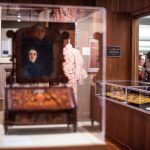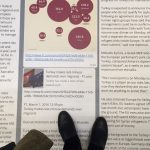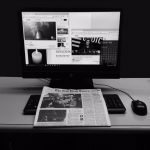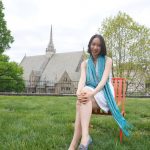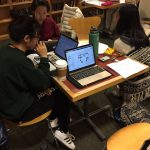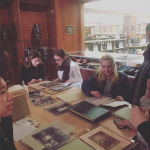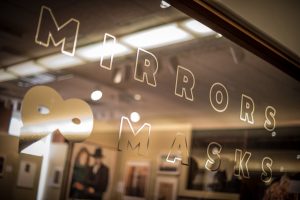
“Mirrors and Masks: Reflections and Constructions of the Self” Exhibition Opening. Outside View. Photo by Bryn Mawr College
An Exhibition of Mirrors, Masks and Me
Introduction
This Bryn Mawr 360 course cluster lets me step into the world of self-exploration through the theme of mirrors and masks. I started from reflecting back on my identity as a Chinese international student in a women’s college and began to learn to work as a group to tuckle new problems.
We had artists, art critics and donors came to visit our class. We also traveled outside the classroom to the national portrait gallery and the Barnes Foundation. The excellent team work led us to the successful opening of the exhibition. Uncountable drafts and meetings prepared us for the real world challenges.
Prof. Robbins once reminded me that “curators are problem-solvers”. Through this year’s attempt of finding the ambigous self, I want this digital exhibition to tell a story of how I explored the self through my encounters with the objects and museum visits and what I gained from the experience working as a member of the group to make decisions for the exhibition.
Hey! Social Media
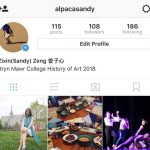
Cultivating my identities online. Instagram @alpacasandy
I used to think that being a curator is to tell a single story of objects and the goal of the spectators is to figure out this narrative in the exhibition. However, when I actually thought about the exhibition from the curator’s point of view, I found myself facing a challenge of making choices among tons of narratives.
Besides doing research and making curatorial decisions, part of the course asked us to document our experience through social media. My instagram account became my new practicing field of self-reflection and how I make new meanings through comparisions.
Posting on social media is telling a story of the self through images and short texts. Part of which showcased my activities as a college student. More importantly, the absence of my body in several posts holds a level of ambiguity about my personality.
Selected posts from my instagram @alpacasandy
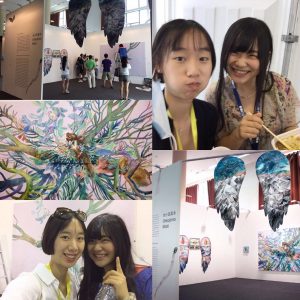
@alpacasandy: Work piece on the middle left: Iomante in the forest-2x3m-Acrylic on wood-2016 New start~Miss you my friend~~Ohkojima Maki 大小島真木👈🏻👈🏻the Cutest artist I met during time in ART NOVA 100. Maki has been to many places in the world, including China, India and Indonesia, to participate in mural projects. Her works depict the story of life, spirits and nature. In her mural paintings, birds, animal totems are dancing on the walls, entangling the trees, the mountains, and the ground. The giant scale and other unique features of mural painting enabled her to celebrate the goddess of the nature and to invoke the awareness of our connection to the hidden world. Artist website:www.ohkojima.com #artnova100 #bmcbanter #selfie360bmc
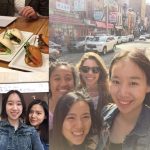
@alpacasandy: Almost my 5th trip to the Barnes Foundation. Always got something new from this rich collection. So excited to hang out with these wonderful curators and my dearest professors in this dreamy spring day~😊#bmcbanter #selfie360bmc #bmc360 #barnesfoundation
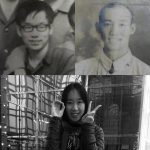
@alpacasandy: Looking at old photos and reflecting how I grew up under my family’s influences. My grandfather,my father and me in our 20s. #selfie360bmc
Selecting Objects – What did I get through
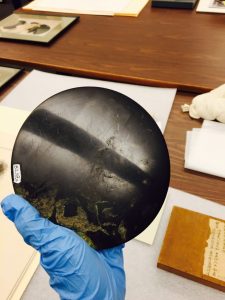
Me with the Chinese Bronze Mirror in the Bryn Mawr Special Collections. Photo by Zixin
One of the most rewarding experiences for me was handling the objects in person. I researched a Chinese bronze mirror in the special collection and never thought about I would see my reflection in the mirror. As a curator, I have this opportunity to go behind the scene to have a personal encounter with the objects. It shortens the distance between me and these objects. Therefore, I can share these stories with my audiences, rather than just pouring out hostorical facts.
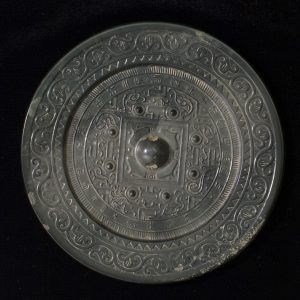
Mirror, Han 206 BCE – 200 CE Bronze Mirror without box: 1/4 in. x 5 1/2 in. (diameter) (0.64 cm x 13.97 cm) Gift of Helen Burwell Chapin, Class of 1914, AB 1915, Bryn Mawr College
From the exhibition catalouge: “The Ancient Chinese believed that all things on earth obey the rule of the cyclical universe, “the unity of man and nature” (tian ren he yi)…Holding the mirror is like holidng the cosmic world in one’s hand and fulfilling the desireable future reflected in the mirror”
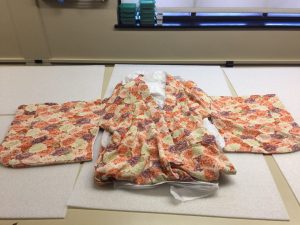
Kimono in Bryn Mawr Special Collections.ca. 1940’s, Textile, 55 in. x 55 in. (139.7 cm x 139.7 cm)
Gift of Elizabeth Gray Vining, Class of 1923. Photo by Zixin
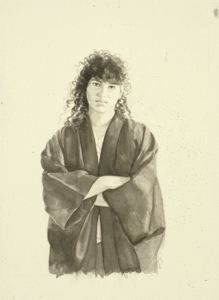
Deborah Deichler American (1948 – ) Dorinne In Kimono 1986, Ink on paper, 20 in. x 16 1/4 in. (50.8 cm x 41.28 cm)
I was intrigue by the connection of Bryn Mawr alumnae and East Asian cultures. This Kimono in the special collections belongs to Bryn Mawr Alumnae Elizabeth Grey Vining, the tutor of the former Japanese Emporer. How this object relates to our theme beyond self-fashioning? I struggled with the question until finally realized that wearing these cultural clothes is a masquerading of a certain cultural identity. The mask also includes the body, as the scholar of African Masks Z. S. Strother acknowledged.
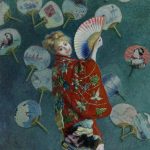
La Japonaise (Camille Monet in Japanese Costume) 1876
Claude Monet (French, 1840–1926), Museum of Fine Arts, Boston
This issue of masquerading in a traditional attire as cultural appropriation led me to the controversial event took place at the Museum of Fine Arts in Boston.In the summer of 2015, MFA launched an event titled “Flirting With the Exotic”. I related this controvercy back to a painting of a non-Japanese woman in a kimono by Deborah Deichler to discuss this topic in relatio to our exhibition.
From the exhibition catalogue: “Who gets to speak for the Japanese body beneath the traditional Kimono?…The kimono acts as both a mask concealing and a mirror revealing the cultral complexity of the self in Deichler’s compelling drawing of Dorinne.”
“Museums should be safe places and they’re not safe places for everybody,” Teitelbaum acknowledged. “We have internal discussions around these issues.”
– “MFA Director On Kimono Controversy: ‘I Think That Was Misguided And Apologize” by By
Outside of the Classroom: Meet new faces!
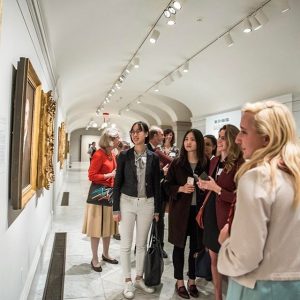
Class Field Trip at the National Portrat Gallery. October 2016. Photo by Bryn Mawr College.

Jessica Todd Harper, “Becky, June, Jessica and Mary”, 2013, On view at the National Portrait Gallery during the class visit.
“…When I think, when I write, when I call in love, my awareness as a woman hardly ever affects me. The only consciousness that I have is of self.”
– Hiratsuka Raichō’s words quoted by Erin Kelley [Schoneveld] in Envisioning the ‘New Woman’: Seitō Magazine and Feminist Aesthetics in Modern Japan
During the luncheon at the National Portrait Gallery, I discussed the problem of museum education with several Bryn Mawr alumnae. They were really patient with my questions about internships and concerns with future careers. What I saw from these women was their passion for the museum and art that kept them in pursuing this field.
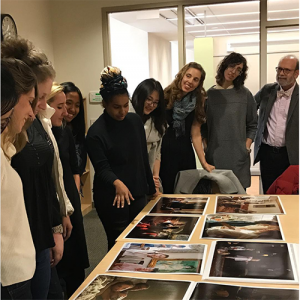
Jessica Todd Harper’s Class Visit. 2016
One of the prize-winning portraits by Jessica Todd Harper was also on viewed at the National Portrait Gallery. Jessica later came to visit our class and shared her story of learning to be an artist at Bryn Mawr. Bryn Mawr College doesn’t offer art courses and art students need to travel to Haverford College.
Jiajia Fei, director of digital at the Jewish Museum of Art, Bryn Mawr 08′, shared her feeling about this problem. “When I wanted to take art courses, I need to traveled to Penn or Haverford. Women get to learn about art, but only men get to make art.”
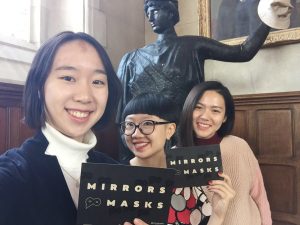
@lilililyyue: So glad to have Jiajia Fei 08′ back to Bryn Mawr! Thanks for the fabulous talk sharing digital museum experiences and artistic initiatives📹 #bmcbanter #bmc360 #selfie360bmc
This might be an internal drawback of our research and curatorial decisions. What does it feel to make these portraits? This might be a future exploration for me in the topic of self and self-reflection. Thanks to these interactions with alumnae, scholars and artists from the different disciplines, I became more confident not only as a public speaker. but also a future curator who has the passion to connect the community with the art world.
Getting together and Brainstorm
Thanks to the various backgrounds of our curators, I got to read interesting researches of mirrors and masks from different cultures through different perspectives. We worked as groups to present curatorial ideas and committee works. The power of the group work truly paid off as our discussion on the multiplicity of the self broaden my understanding of the artworks beyond my cultural identity.
Our initial floor plans of the exhibition separated the space into smaller sections according to their functions and themes. We created lots of walls in order to insert more pictures. Another issue we were concerned about is the wide-range of time and culture of our collections. How to provide more connections in the space. and how can we avoid the mistakes of appropriating certain cultures? Less is more. This short sentence concludes what I learned from this process after we rejected to put up more walls to squeeze more objects into our exhibition. Looking back to the exhibition from a visitor’s point of view, the exhibition changed into a more friendly and open design with a managable number of objects from our rich collections.
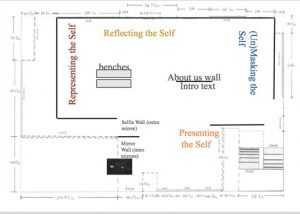
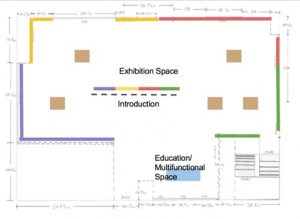
Exhibition floor plans presented by the two groups. We can already see some similarities in the placement of objects and walls. All the objects are grouped into a certain theme, but we tried to open up the space for potential connections across sections.
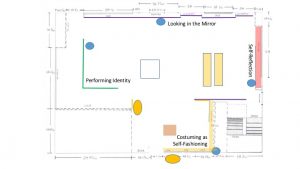
The final floor plan featured a trio of M Carey Thomas’s Portrait, her mirror case and Miram Shapiro’s painting at the entrance. This highlights the collection and the title “mirrors and masks” and helps us to navigate through the four themes at the same time.
Real-world practices and Moving forward
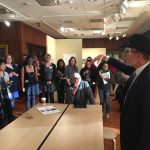
The opening Masquerade Party. March, 2017. Photo by Zixin
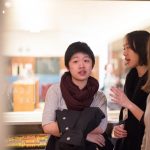
Me (left) at the opening. March, 2017. Photo by Bryn Mawr College
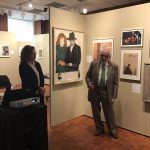
Artist tour by Sigmund Abeles (right) and Nora Lavori (left). March, 2017. Photo by Lizhu
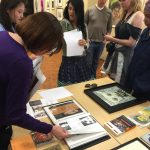
Artist Lecture by Rachel Bliss (center). April, 2017. Photo by Zixin
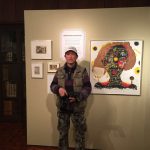
Wang Bode, scholar from China at the exhibition. April, 2017. Photo by Zixin
Xiaoya, Zichu, Abi and I were members of the event committee. We planned the opening masquerade, promoted artists lecture seires and sent press-release to universities and local communities. The big difficulty for us was how learn from this real-world practices as a part of our exhibition. Because the limit of our ability and time, we ended up cutting off many of our activities. This practice really got me involved with the community as they participated in our events. Different opinions and critics brought by outside scholars and critics also reminded me of the exciting exhibitions going on around us. As a final take-away of the course, I am grateful that this experience allows me to understand my self as an ambiguious subject. I have the potentional to connect to the world of art through this exploration of identities. I am ready to meet more people in the art field and have a deeper discussion.
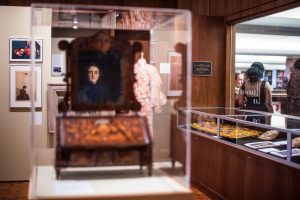
“Mirrors and Masks: Reflections and Constructions of the Self” Exhibition Opening. M. Carey Thomas’s Portrait Reflected in her Mirror. Photo by Bryn Mawr College
Special thanks to the Bryn Mawr 360 Program, Prof. Steven Z. Levine, Prof. Carrie Robbins, our teaching assistant Laurel McLaughlin, my fellow curators, and all the faculties, alumnae and staff who have contributed to our class experience and supported the exhibition.
References:
http://www.mfa.org/collections/object/la-japonaise-camille-monet-in-japanese-costume-33556
http://www.wbur.org/artery/2016/02/08/mfa-kimono-controversy
http://npg.si.edu/blog/outwin-2016-finalist-jessica-todd-harper
Erin Kelley [Schoneveld], “Envisioning the ‘New Woman’: Seito Magazine and Feminist Aesthetics in Modern Japan,” Modern Art Asia 8 (November, 2011).
Strother, Z. S. “Invention and Reinvention in the Traditional Arts.” African Arts 28, no. 2 (1995): 24-90. doi:10.2307/3337223.
Exhibition Website: http://scalar.usc.edu/works/mirrors–masks/index
Exhibition Hashtag: #selfie360bmc

